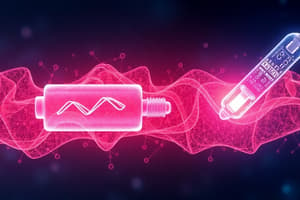Podcast
Questions and Answers
Which cells in the islets of Langerhans produce insulin?
Which cells in the islets of Langerhans produce insulin?
- δ cells
- β cells (correct)
- α cells
- F cells
What is the primary function of glucagon?
What is the primary function of glucagon?
- Facilitate digestive processes
- Promote glucose uptake
- Increase hepatic glucose output (correct)
- Lower blood glucose concentration
Which organ is primarily responsible for storing glycogen?
Which organ is primarily responsible for storing glycogen?
- Liver (correct)
- Skeletal muscles
- Bones
- Adipose tissues
What stimulates insulin release?
What stimulates insulin release?
What results when insulin secretion is insufficient to maintain normal blood glucose concentrations?
What results when insulin secretion is insufficient to maintain normal blood glucose concentrations?
Which of the following is a known side effect of insulin therapy?
Which of the following is a known side effect of insulin therapy?
How does insulin affect blood glucose concentration?
How does insulin affect blood glucose concentration?
What occurs within 30 minutes of starting a meal in a healthy individual?
What occurs within 30 minutes of starting a meal in a healthy individual?
Non-insulin Dependent Diabetes Mellitus is most commonly found in which population?
Non-insulin Dependent Diabetes Mellitus is most commonly found in which population?
What is the role of δ cells in the islets of Langerhans?
What is the role of δ cells in the islets of Langerhans?
Which of the following tissues does NOT require insulin for glucose transport?
Which of the following tissues does NOT require insulin for glucose transport?
Which medication inhibits the conversion of complex carbohydrates to monosaccharides?
Which medication inhibits the conversion of complex carbohydrates to monosaccharides?
What happens to blood glucose levels typically within 1-2 hours after a meal?
What happens to blood glucose levels typically within 1-2 hours after a meal?
Which hormone primarily regulates glucose metabolism in the body?
Which hormone primarily regulates glucose metabolism in the body?
Which statement about diabetes mellitus is INCORRECT?
Which statement about diabetes mellitus is INCORRECT?
What is the correct description of Type 1 diabetes?
What is the correct description of Type 1 diabetes?
What is Type IV Diabetes Mellitus primarily associated with?
What is Type IV Diabetes Mellitus primarily associated with?
Which type of diabetes accounts for the majority of cases?
Which type of diabetes accounts for the majority of cases?
The primary purpose of the therapy for Diabetes Mellitus is to:
The primary purpose of the therapy for Diabetes Mellitus is to:
Which of the following is NOT a type of injected insulin?
Which of the following is NOT a type of injected insulin?
Which tissues do NOT require insulin for glucose transport?
Which tissues do NOT require insulin for glucose transport?
What characteristic of rapid-acting and short-acting insulins improves their stability?
What characteristic of rapid-acting and short-acting insulins improves their stability?
Which of the following statements describes Type III Diabetes Mellitus?
Which of the following statements describes Type III Diabetes Mellitus?
What is the duration of action for long-acting insulin?
What is the duration of action for long-acting insulin?
Insulin is produced by _________ cells in the islets of Langerhans.
Insulin is produced by _________ cells in the islets of Langerhans.
Insulin is usually used in __________.
Insulin is usually used in __________.
Non-insulin Dependent Diabetes Mellitus is due to __________.
Non-insulin Dependent Diabetes Mellitus is due to __________.
Islets of Langerhans contains __________.
Islets of Langerhans contains __________.
__________ diabetes is believed to be an autoimmune disease.
__________ diabetes is believed to be an autoimmune disease.
Insulin receptors are located on the plasma membrane of __________.
Insulin receptors are located on the plasma membrane of __________.
Select the oral anti-diabetic agent.
Select the oral anti-diabetic agent.
Sulfonylureas such as glibenclamide and glypizide __________.
Sulfonylureas such as glibenclamide and glypizide __________.
What feature distinguishes long-acting insulins like insulin glargine and insulin detemir?
What feature distinguishes long-acting insulins like insulin glargine and insulin detemir?
How does amylin help in glucose management after meals?
How does amylin help in glucose management after meals?
What is the primary action of incretin mimetics like exenatide?
What is the primary action of incretin mimetics like exenatide?
Which class of oral anti-diabetic drugs aids in delaying glucose absorption?
Which class of oral anti-diabetic drugs aids in delaying glucose absorption?
What is one major characteristic of intermediate-acting NPH insulins?
What is one major characteristic of intermediate-acting NPH insulins?
Pramlintide is classified as which type of treatment?
Pramlintide is classified as which type of treatment?
What is the effect of combining short-acting and long-acting insulins?
What is the effect of combining short-acting and long-acting insulins?
Biguanides help lower blood glucose levels by acting on which of the following?
Biguanides help lower blood glucose levels by acting on which of the following?
Which antidiabetic drug is known to increase tissue sensitivity to insulin?
Which antidiabetic drug is known to increase tissue sensitivity to insulin?
Which drug functions as an inhibitor of alpha glucosidase?
Which drug functions as an inhibitor of alpha glucosidase?
What is primarily used in the treatment of Type I Diabetes Mellitus?
What is primarily used in the treatment of Type I Diabetes Mellitus?
Glucagon primarily functions to __________.
Glucagon primarily functions to __________.
Which statement about diabetes mellitus is FALSE?
Which statement about diabetes mellitus is FALSE?
What is the classification of Type I Diabetes Mellitus?
What is the classification of Type I Diabetes Mellitus?
Which of the following conditions is NOT associated with Type II Diabetes Mellitus?
Which of the following conditions is NOT associated with Type II Diabetes Mellitus?
Which statement correctly describes a characteristic of insulin secretion?
Which statement correctly describes a characteristic of insulin secretion?
Flashcards
Islets of Langerhans
Islets of Langerhans
Clusters of cells within the pancreas responsible for producing hormones like insulin and glucagon. They play a vital role in blood sugar regulation.
Insulin
Insulin
A hormone released by the beta cells of the pancreas, responsible for lowering blood sugar by promoting glucose uptake, utilization, and storage.
Glucagon
Glucagon
A hormone released by the alpha cells of the pancreas, responsible for raising blood sugar by stimulating the liver to release stored glucose.
Diabetes Mellitus (DM)
Diabetes Mellitus (DM)
Signup and view all the flashcards
Basal Insulin Release
Basal Insulin Release
Signup and view all the flashcards
Meal-Related Insulin Secretion
Meal-Related Insulin Secretion
Signup and view all the flashcards
Insulin Sensitivity
Insulin Sensitivity
Signup and view all the flashcards
Blood Glucose Regulation
Blood Glucose Regulation
Signup and view all the flashcards
What is Type I Diabetes?
What is Type I Diabetes?
Signup and view all the flashcards
What is Type II Diabetes?
What is Type II Diabetes?
Signup and view all the flashcards
What is Gestational Diabetes?
What is Gestational Diabetes?
Signup and view all the flashcards
What is Type III Diabetes?
What is Type III Diabetes?
Signup and view all the flashcards
What are parenteral drugs?
What are parenteral drugs?
Signup and view all the flashcards
What is Insulin?
What is Insulin?
Signup and view all the flashcards
What are insulin-dependent cells?
What are insulin-dependent cells?
Signup and view all the flashcards
What is the general therapy for diabetes mellitus?
What is the general therapy for diabetes mellitus?
Signup and view all the flashcards
Long-acting Insulin Analogs
Long-acting Insulin Analogs
Signup and view all the flashcards
Short-acting Insulin Analogs
Short-acting Insulin Analogs
Signup and view all the flashcards
Amylin
Amylin
Signup and view all the flashcards
Pramlintide
Pramlintide
Signup and view all the flashcards
Incretins
Incretins
Signup and view all the flashcards
Incretin Mimetics
Incretin Mimetics
Signup and view all the flashcards
Secretagogues
Secretagogues
Signup and view all the flashcards
Alpha-glucosidase Inhibitors
Alpha-glucosidase Inhibitors
Signup and view all the flashcards
What are Sulfonylureas?
What are Sulfonylureas?
Signup and view all the flashcards
What are Thiazolidinediones?
What are Thiazolidinediones?
Signup and view all the flashcards
What are Oral Antidiabetic Agents?
What are Oral Antidiabetic Agents?
Signup and view all the flashcards
What is Glucagon?
What is Glucagon?
Signup and view all the flashcards
What are Insulin Receptors?
What are Insulin Receptors?
Signup and view all the flashcards
What are Biguanides?
What are Biguanides?
Signup and view all the flashcards
Type I Diabetes
Type I Diabetes
Signup and view all the flashcards
Type II Diabetes
Type II Diabetes
Signup and view all the flashcards
Hypoglycemia
Hypoglycemia
Signup and view all the flashcards
What are insulin secretogogues?
What are insulin secretogogues?
Signup and view all the flashcards
What are alpha-glucosidase inhibitors?
What are alpha-glucosidase inhibitors?
Signup and view all the flashcards
What are non-insulin dependent cells?
What are non-insulin dependent cells?
Signup and view all the flashcards
Study Notes
Chapter 5: Drugs for Diabetes Mellitus
- Learning Outcomes:
- Describe pancreatic hormones and functions
- Describe different types of diabetes mellitus
- Describe pharmacology of drugs for diabetes
- Structure of the Lesson:
- Pancreas and pancreatic hormones
- Regulation of blood glucose
- Diabetic Mellitus
- Drugs for Diabetic Mellitus
- Hyperglycemic Drugs
- Pancreas and Pancreatic Hormones:
- Hormones are produced in clusters called islets of Langerhans
- Islets contain alpha, beta, delta, and F cells
- Alpha cells produce glucagon
- Beta cells produce insulin
- These hormones regulate glucose metabolism and blood glucose levels
- Insulin promotes glucose uptake and storage, lowering blood glucose
- Glucagon increases hepatic glucose output and raises blood glucose
- Regulation of Blood Glucose:
- Healthy people release basal insulin throughout the day
- Blood glucose peaks about 30 minutes after a meal
- Insulin is released immediately when eating to balance glucose levels from a meal
- Blood glucose usually returns to normal within 1-2 hours after a meal
- Glucose binds to receptors on beta cells, stimulating insulin release
- Insulin binds to receptors in skeletal/heart muscle and adipose tissue, allowing glucose intake, lowering blood glucose
- Diabetes Mellitus:
- A disorder of glucose homeostasis characterized by elevated blood glucose
- Classified into four categories: Type 1, Type 2, Type 3, and Type 4 (Gestational)
- Type 1 Diabetes:
- Usually develops before age 30
- Autoimmune disease triggered by viral infection or environmental factor
- Destroys beta cells, causing insulin deficiency
- Requires exogenous insulin for survival
- Type 2 Diabetes:
- Usually develops after age 30
- Often has normal or elevated insulin levels, but cells are less responsive (insulin resistance)
- Often treated with oral anti-diabetic medications and lifestyle changes
- Type 3 Diabetes:
- Elevated blood glucose caused by pancreatitis, pancreatectomy, etc.
- Type 4 (Gestational) Diabetes:
- Glucose intolerance during pregnancy
- Typically resolves after delivery
- Drugs for Diabetes:
- Therapy involves diet control, exercise, and drug administration
- Drugs are categorized into parenteral (injected) and oral administration
- Insulin:
- Binds to insulin receptors, regulating blood glucose and metabolism
- Receptors are in adipose tissue, liver, skeletal muscles, and other tissues
- Nerves, red blood cells, kidneys, and lens of the eye do not require insulin for glucose transport
- Four types based on onset and duration: Rapid-acting, short-acting, intermediate-acting, and long-acting
- Amylin Analogs:
- Co-secreted with insulin by beta cells
- Slows gastric emptying
- Suppresses glucagon secretion
- Incretin Mimetics:
- Peptide hormones from the duodenum
- Stimulate insulin, inhibit glucagon, and slow stomach emptying
- Exenatide is an example that activates incretin receptor
- Secretagogues:
- Increase insulin production and release (not for Type 1)
- Alpha-glucosidase Inhibitors:
- Delay glucose absorption for slower postprandial blood glucose rise
- Biguanides:
- Decrease liver glucose production and increase intestinal glucose absorption
- Metformin is an example
- Thiazolidinediones:
- Increase insulin sensitivity in muscle, fat, and liver cells
- Rosiglitazone is an example
- Dipeptidyl peptidase-4 (DPP-4) inhibitors:
- Prolong the activity of incretin GLP-1 to increase insulin production and reduce glucagon
- Sitagliptin is an example
- Hyperglycemic Drugs:
- Glucagon is used to treat low blood sugar
- Administered subcutaneously
Tutorial: Multiple Choice Questions
(This section contains multiple-choice questions. Please refer to the original text for the answer options to each question.)
Short Essay Questions
(This section contains open-ended questions. Please refer to the original text for the context.)
Studying That Suits You
Use AI to generate personalized quizzes and flashcards to suit your learning preferences.




